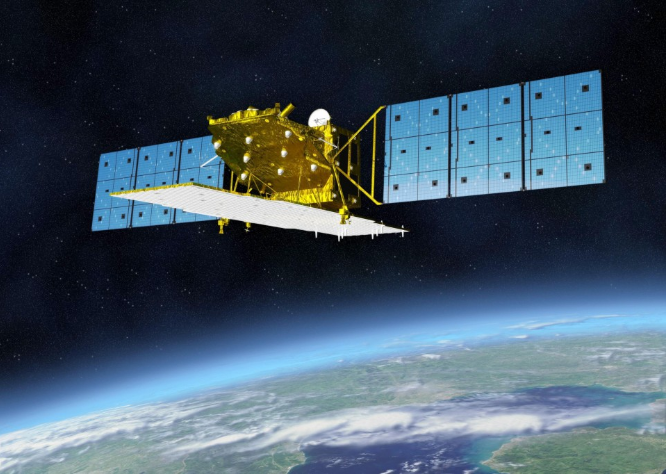
(Japan Aerospace Exploration Agency)
Japanese government sources said on January 26th that Japan has started scheming the new US-Japan joint operational plan between the Japan Self-Defense Forces and the US military. Scopes including land, sea, air, space, cyberspace, and electromagnetic space are included in the new operational plan. These actions demonstrate that Japan attaches great importance to space much as the conventional combat domains, and Japan has achieved a lot in its space militarization process.
Japan has proposed a series of development plans at the national and defense force building level since 2018. Statements of those plans fully reflects Japan's ambition of being a great country of powerful space military. The Committee on the National Space Policy of the Japanese Cabinet officially announced the 2018 Basic Plan on Space Policy on December 11th, 2018. The policy clarifies detailed moves of related space program before 2034 and basically covers the current core space militarization projects in the country.
A few days after the publication, Japan proposed the new theory of 'cross-domain operation' in the new National Defense Program Guidelines and a medium-term defense program. The theory emphasizes the integration of new combat domains in space, cyberspace, and electromagnetic spectrum, along with traditional land, sea, and air combat domains to build a multi-domain integrated defense force.
In terms of equipment capabilities, Japan has focused on building a more complete 'reconnaissance-attack-defense-support' space combat system. In terms of the building of defense force, Japan has proposed setting up space forces under the Japan Air Self-Defense Force and building rapid response and recovery capabilities in wartime. In terms of international cooperation, Japan proposed deepening cooperation with the United States in the space field, especially in international discussions, information sharing, and multilateral exercises.
In recent years, Japan has laid a solid foundation for its space militarization in policy, capability building, and system deployment. As early as 2008, the Basic Space Law passed by the Japanese National Diet deleted the words "space development is limited to peaceful use". Instead, it backs "non-offensive" use. On August 29th, 2018, Japanese Prime Minister Shinzo Abe stressed at a meeting of the Advisory Panel on National Security and Defense Capabilities held at his official residence that Japan should maintain its advantages in space and cyberspace, and said "It is crucial for Japan's defense to maintain its advantage in the new field." This is a clear signal that Japan will achieve military normalization in space and other new areas.
As for space military power building, Japan has also started the establishment of a sound space defense force system. In December 2017, the Japanese government announced that it would form an integrated command to unify the leadership of combat abilities building in the three sophisticated areas of space, cyberspace, and electromagnetic space. Japanese media reported in November 2018 that the Japanese government added 26.8 billion yen ($242 million) in the 2019 national budget declaring to build a "space force". The Japanese Defense Ministry said that the main task of the space force is to monitor space through ground-based radars and radars carried on aircraft. The content of monitoring includes crashes of man-made satellites and rocket along with other kinds of space debris, as well as other countries’ satellites.
As for the deployment of space military system, Japan has basically formed a sound and complete military satellite application system. In terms of reconnaissance and surveillance, Japan has deployed as many as 16 optical and radar reconnaissance satellites, forming a real-time space reconnaissance and surveillance capability to conduct twice of reconnaissance every day in every area of the world. In terms of satellite navigation, Japan is accelerating the development of its Quasi-Zenith navigation satellite system. With the initial formation of a four-star operation system built in 2018, Japan plans to achieve a seven-star operation system by 2023, thereby eliminating the dependence on GPS. In terms of satellite communication, Japan plans to launch a total of three X-band defense communication satellites (geostationary orbit communication satellites) to provide high-speed, large-capacity direct communication between its Army, Navy, and Air Self-Defense Forces.
In general, Japan's strong aerospace technology base and the strategic needs of the US-Japan military alliance are important foundations for Japan's rapid space militarization.
Japan's continuous deep military cooperation with the United States in the space field since contributes to a more stabilized and closer US-Japan military alliance. This is especially reflected in the integration of US-Japan space military systems, integrated space military support, and space military activities. In 2018, Japan sent personnel to participate in the Global Sentinel space exercise and Schriever Wargame 2018 conducted by the US military. Japan also plans to participate in the 13th Schriever space exercise to be held by the US Space Command in the fall of 2020. And there are also reports that Japan wants to cooperate with the United States to send Japanese astronauts to the Moon.
It can be projected that Japan will soon build a strong space military power system, thus promoting its "going global" defense policy more proactively in the Asia-Pacific region. In this way, other Asian countries must remain vigilant.
(The author is Wang Peng from the Air Force Engineering University of the People’s Liberation Army)













